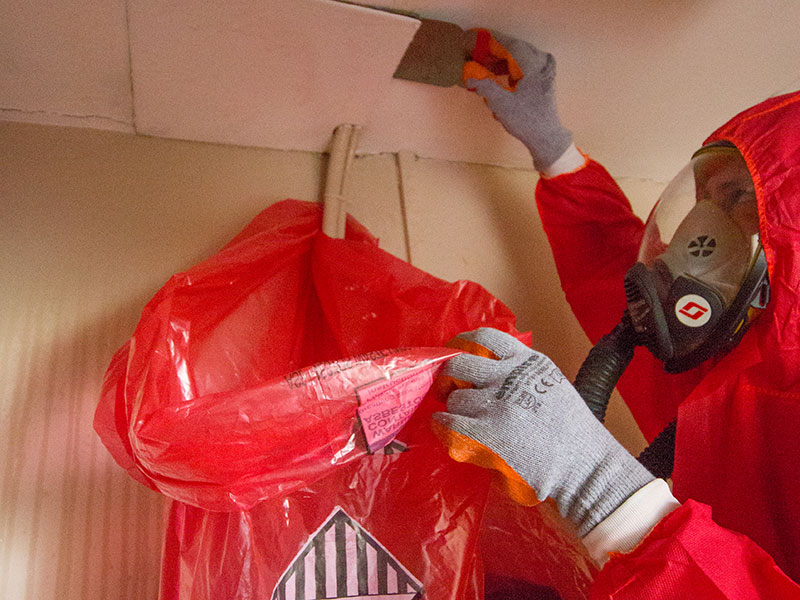How should you dispose of asbestos waste?
Although the importation and use of the carcinogenic mineral known as asbestos has been banned in the UK since 1999, the legacy of the material’s long period of extensive use continues to make itself felt.
Asbestos-containing materials (ACMs) were especially frequently used from the 1960s to the 1980s, and the substance remains present in many buildings in the UK to this day. It is therefore very possible that people working in certain industries, such as construction and plumbing, could still be exposed to asbestos fibres in the 2020s, with all the long-term health risks this could bring.
Asbestos is not thought to pose a risk to health if it is in good condition and undisturbed. However, in some cases, there might be a high chance of disturbance to on-site ACMs – which in turn, might necessitate the removal of the materials to eliminate the health risk to users of the given buildings.
So, in managing the asbestos on premises for which you are responsible, there might be a need for you to know how to dispose of asbestos waste. Below, we have set out the essentials you should know.
What are the regulations around asbestos disposal?
If a given asbestos product or material is ready for disposal, it is defined as asbestos waste. Other examples of asbestos waste include contaminated building materials, tools that cannot be decontaminated, damp rags used for cleaning, and personal protective equipment (PPE).
Various regulations apply in different parts of the UK in relation to asbestos disposal:
- In England and Wales, asbestos waste is ‘hazardous waste’ when more than 0.1% of the waste is asbestos. Such waste is subject to the Hazardous Waste Regulations 2005. There will be an associated need to complete a Hazardous Waste Consignment Note.
- In Scotland, asbestos waste is ‘special waste’ when more than 0.1% of the waste is asbestos. Such waste is subject to the Special Waste Amendment (Scotland) Regulations 2004. Again, there will be a requirement to complete a Hazardous Waste Consignment Note.
- In England, Scotland and Wales, Schedule 2 of The Control of Asbestos Regulations 2012 (CAR 2012) applies to all asbestos waste. In addition, most waste is subject to The Carriage of Dangerous Goods and Use of Transportable Pressure Equipment Regulations 2009 (CDG 2009). Firmly-bound asbestos – asbestos cement or articles with asbestos reinforcement which do not easily release respirable or hazardous fibres – are not subject to CDG. However, the hazardous and special waste regulations are still applicable to such materials. CDG must be followed for all other asbestos waste.
Essential things you must do
With asbestos being such a potentially harmful material to anyone who comes across it and inhales or ingests it, you should be well-educated on the steps to take to ensure a safe disposal process. Such essential things include:
- Do not attempt to remove the asbestos yourself. It is crucial to only carry out work on asbestos if you have been properly trained and have the necessary equipment. Furthermore, in order to transport waste, one must have a waste carriers licence. Entrusting the sensitive and potentially dangerous work of asbestos removal and disposal to an accredited contractor will help give you the utmost peace of mind.
- Make sure all waste is double-bagged. The Health and Safety Executive (HSE) stipulates that asbestos waste should be double-wrapped and labelled. It is standard practice to use a red inner bag with asbestos warnings, as well as a clear outer bag with the CDG label, if this is required. The packaging in which the waste is packed must be UN-approved, and should show visible asbestos code information.
- Wear PPE and dispose of contaminated PPE. Not only is the wearing of personal protective equipment (PPE) crucial during the process of asbestos disposal, but you should also treat any asbestos-contaminated PPE as asbestos waste, or have it cleaned at an appropriately equipped facility. In the event of your personal clothing becoming contaminated, you are required to treat it in the same way as contaminated PPE.
- Do not mix with other waste materials. It is crucial that you do not mix asbestos waste with other types of waste, as some people might be tempted to do in order to get the percentage of asbestos to below 0.1%.
How to transport asbestos material
One of the great risks involved in attempting to transport asbestos waste to licensed landfill sites, is that of the material being disturbed during transit. So, certain highly controlled measures should be adopted to help ensure a minimal risk of disturbance:
Asbestos skips
Once a suitably qualified professional has removed the asbestos and double-bagged it in accordance with the approved code of practice, the material can be sealed in a lockable skip. This will allow the direct transportation of the material to a licensed landfill site for disposal.
Asbestos skips are available in a variety of sizes, to help ensure a solution is available for projects of a similarly wide range of sizes. When at the landfill site, the skip driver will be required to wear the appropriate PPE and respiratory protective equipment (RPE), to help protect themselves while tipping within the dedicated asbestos cell.
Asbestos disposal sites/transfer stations
If there is a smaller volume of asbestos waste to dispose of, a licensed asbestos transfer station – also sometimes referred to as an ‘asbestos disposal site’ – may be used. An asbestos transfer station is required to hold an environmental permit that is approved and regulated by the Environment Agency.
The process of using an asbestos disposal site is similar to that for skip hire, with the asbestos waste first needing to be removed in line with the relevant codes of practice, and double-bagged or wrapped.
The subsequent transportation to the disposal site involves the placement of the asbestos waste in a separate compartment, such as a specialist van. The arrival of the vehicle at the transfer station is followed by the transferral of the waste from the van’s sealed area or container, into a locked skip at a licensed site.
Methods of asbestos disposal
Whichever of the above methods you choose for disposal of your asbestos waste, you should ensure the company moving the waste is a registered waste carrier. In addition, you should check that the given company will be taking the waste to a site that has a waste management licence or permit showing that the site is fully authorised to receive the asbestos waste.
Remember that the illegal dumping of asbestos waste can attract a hefty fine, and even a prison sentence in some cases. This is one more reason to look for an accredited asbestos removal company, which will be able to undertake the crucial asbestos disposal processes for you.
Here at Oracle Solutions, for example, we are fully licensed by the HSE to carry out the full range of work with asbestos, including both the removal and disposal of this material. In addition, we are licensed by the Environment Agency to transport hazardous waste for disposal, and our personnel benefit from the very highest standards of training.
How is asbestos destroyed?
You might be wondering whether it is possible to simply destroy asbestos, which would also have the effect of destroying any current and future asbestos liability you could possibly have in relation to the specific materials. And the answer to that question is: yes and no.
We say “yes”, because in recent years, certain projects have indeed discovered ways to successfully destroy all traces of hazardous asbestos waste – for example, through the use of physical/chemical processes, or even a reactor system.
However, at the time of writing, these methods have not yet begun to be used in the UK. So, as things stand, there is no legal option in the UK to simply destroy asbestos waste; instead, it must be buried in landfill.
What next steps should you take if you need to dispose of asbestos?
You might understandably be unsure where to start when it comes to the legal, responsible, and safe management of ACMs on a site for which you have a duty to manage asbestos. Even if you know you will be looking to dispose of asbestos waste, it may be far from obvious to you which services you should take advantage of, or who you should ask for advice.
So, why not reach out to our own accredited and licensed asbestos professionals at Oracle Solutions today, in order to have that first conversation about your requirements? Call us today, or send us an email, and you will also be able to request a fast and free asbestos quote.

Written by Mark Carter
Mark Carter is a renowned expert in asbestos management, offering clients vital guidance on compliance and safety. His expertise is invaluable for navigating asbestos regulations, ensuring both safety and legal adherence. Mark's role is central in providing effective asbestos-related solutions, helping clients achieve their business objectives with an emphasis on regulatory compliance and safety in asbestos management.

